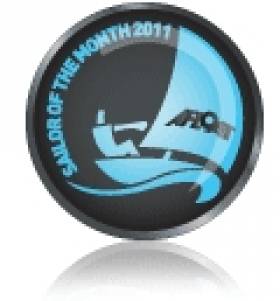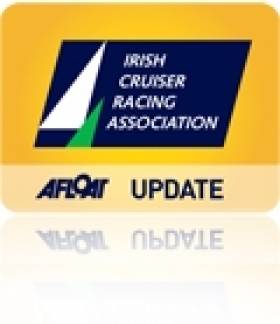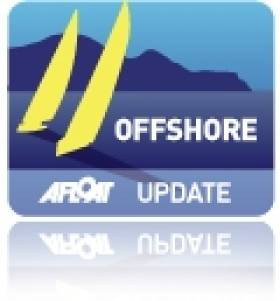Displaying items by tag: Irish Independent
Afloat/Irish Independent Sailor of the Month
Created in 1996, the Afloat Sailor of the Year Awards represent all that is praiseworthy, innovative and groundbreaking in the Irish sailing scene.
This is a national award especially designed to salute the achievements of Ireland's sailing's elite.
Over nearly two decades the awards has developed in to a premier awards ceremony for water sports.
Since it began 17 years ago the awards have recognised over 200 monthly award winners in the pages of Ireland's sailing magazine Afloat and these have been made to both amateur and professional sailors.
The first ever sailor of the year was Dinghy sailor Mark Lyttle.
Now proudly in its 18th year we've already recognised sailors, ex-pat gordon Maguire from Howth for for his dramatic win in January's Sydney-Hobart race became the first monthly winner in 2013 and the account of his exploits are on this website.
As a sport we often grumble that sailing doesn't get the recognition it deserves but through these awards and the support of our sponsors past and present there is a bigger chance of presenting the remarkable achievements of Irish sailors that all too often do not get the media coverage that we all think they deserve.
An online readers poll plus a vote from a panel of sailing journalists and administrators select the annual winner.
Cruise from Kinvara to Tahiti Wins Sailor of the Month Award
Recognised by the senior offshore sailing organisation, the Irish Cruising Club, with the award of the historic Faulkner Cup, the Quinlan's achievement is further enhanced by the fact that, in their determination to acquire a boat suitable for long distance voyaging, they built their steel-constructed 40ft cutter Pylades themselves, launching in 1997.

They have brought a lively and enquiring eye to the complex project, something which reflects Fergus's qualifications as an architect. As he has drily observed himself, there isn't a lot of work around for architects in Ireland at the moment, so everything clicked with the boat sea-tested and ready to go off on this sail of a lifetime.
Having left Kinvara in June 2009, their longterm plan is a global circumnavigation, returning to Galway Bay in August 2012. Quite what Ireland will be like by then is anybody's guess. But as it is, the crew of Pylades have enough to be getting on with in dealing with the vagaries of the open ocean, and the volatile political situation in some of the areas where ocean voyagers go. For armchair sailors at home, their thoughtful and entertaining reports on their experiences make them worthy "Sailors of the Month".
National Award for Irish Cruiser Racing Association (ICRA)
In the three decades and more of the Mitsubishi Motors/Irish Independent "Sailing Club of the Year" assessments, there has never been an organization only seven years old winning the title.
In fact, seniority has often won the day, though in a country in which the oldest sailing clubs date from 1720 (Royal Cork) and 1770 (Lough Derg), it's difficult to find clubs and associations which are anything less than centenarians, let alone not yet in double figures.
But it was only as recently as June 2003 that the Irish Cruiser Racing Association came into being. It was at the biennial Sovereign's Cup series in Kinsale that Fintan Cairns of Dun Laoghaire, enthusiastically supported by the late Jim Donegan of Cork and other key personnel, successfully launched the idea of a nationwide organisation to co-ordinate the racing sport of "boats with lids".
At the time, it was a leap of vision. Having successfully headed Dublin Bay Sailing Club at a time of rapid growth, he was able to see the picture more clearly than those who reckoned that offshore racing organisations should be related to bodies of water rather than a land mass, for all that we're on an island.
Then too, the new association was envisaged as using established clubs and their facilities to stage its championship. In other words, the ICRA organising team would be the travelling people of the Irish sailing scene. On top of that, handicap competition with cruiser-racers was derided as "truck racing" by the white hot one design and dinghy sailors.
Yet the idea took hold, and the annual championship was successfully staged at venues as various as Crosshaven, Tralee, Howth, Kinsale and Dun Laoghaire, with Denis Kiely the essential ace number-cruncher in the back office. And in May 2010, with the mighty machine of the Royal St George YC in Dun Laoghaire providing the administrative centre, the Liebherr Irish Cruiser Nationals in Dublin Bay attracted a fleet of 117 boats, with great sailing.
On that event alone, ICRA would have been among the front runners for Club of the Year. But the best was yet to come. In recessionary times, getting a three boat team together to make a worthwhile challenge for the biennial Rolex International Commodore's Cup was a matter of making the best of limited resources. But ICRA – currently under the leadership of Barry Rose of Cork - was up to the job.
The team of Anthony O'Leary's Antix, Dave Dwyer's marinerscove.ie, and Rob Davis and Andrew Creighton's Roxy 6, had a convincing win. Thus ICRA in one season had catered very well for general run of boats and crews at home, and had come out tops at the top level internationally. It doesn't get better than that, and we salute them as Sailing Club of the Year 2011.
Nicholas O'Leary is Afloat's November Sailor of the Month
Nicholas "Nin" O'Leary of Cork has re-written the Irish sailing records, and he's only 24. The new All Ireland Champion Helm is clear winner of the Afloat.ie/Irish Independent "Sailor of the Month" award for November after a nail-biting finale in difficult conditions off Kinsale, making it three-in-a-row for this junior skipper who was winning major titles with impressive scorelines well before he was out of his teens.
The wind was drawing from the east for the 20th November shootout in the ISA's SailFleet of J/80s. But the challenge lay in the fact that, after a week of strong winds up to gale force, a massive swell was rolling in past the Bulman Buoy to provide sea conditions which were out of sync with the strength of the breeze.
Yet the three top Royal Cork helms showed they were up to the challenge. In fact, it was Neil Kenefick, in the championship through being tops in the ICRA series in 2010, who best got to grips with the racing in the early stages, posting two wins with Anthony O'Leary second in the first race, while son Nicholas was second in the next one.
But the junior O'Leary moved nearer to retaining the title by winning the third, though his father was right there with a second, while James Espey from the Lasers posted a third. However, Kenefick was in touch with a fourth, but that became his discount as he nailed a couple of thirds in the two concluding races.
Going into the fifth and final race, the three Crosshaven helms were neck-and-neck on points, but O'Leary Junior put it neatly away by slicing in ahead of his father, with Kenefick third. The Corkmen were out on their own, as next in line was Puppeteer 22 Champion Garret May, but he concluded with 18 net points, while Neil Kenefick was on 8, Anthony O'Leary on 7, and Nicholas O'Leary the supreme champion on 6. And making a bit of history while he was at it - the first three-in-a-row in the All Ireland's 64 years.
Moore Plays Role in Lucky's Break
Today, in the ancient fortress city of Valletta, the former 16th century "Sacra Infermeria" of the Order of St John of Jerusalem, was host to the prize giving for the 31st edition of the Rolex Middle Sea Race. Close to eight hundred guests – skippers, crews, family and friends – were on hand to collect trophies and awards for the Royal Malta Yacht Club's premier offshore race.
Ireland had a role in the win as the Navigator of the winning yacht was Northern Ireland's Ian Moore of Carrickfergus. More on this from WM Nixon in the Irish Independent HERE.
The former 16th century hospital, located adjacent to Fort St Elmo and overlooking an historically accurate restoration in the late 1970s, which earned it numerous design awards. In a city rich in history, the Sacra Infermeria is an impressive edifice, and was considered to be one of the best hospitals in Europe, one that could accommodate over 900 patients in an emergency.
The main hall, measuring 155 metres in length, was at that time, one of the largest in Europe and was described as "one of the grandest interiors in the world." Surviving four direct hits during the bombardment of WWII, the building was repaired and later served all sorts of uses: as a command hall, an entertainment centre, a children's theatre, a school, and finally in the late 1970s, a modern conference center.
Seventy-six boats started the race, and 60 finished, one of the highest numbers of finishers in recent years. The fleet included boats from 17 nations, a veritable United Nations of competitors and certainly along the quay at Grand Harbour Marina, boats from Hungary, Italy, UK, US, Spain, and Slovenia, among others, bore this out.
At the prize giving, Royal Malta Yacht Club Commodore, George Bonello DuPuis thanked the competitors, event organizing committee, the international jury, yacht club staff and volunteers, and race sponsor Rolex. The Commodore was clearly pleased and he said, "I was asked how I would summarise this year's event and the first word that came to mind was "epic", as I'm sure many of you who competed would agree."
The race started last Saturday, in Grand Harbour, Valletta, on a day full of bright sunshine and blue skies. With the start signals from the Saluting Battery cannon at the Upper Barrakka Garden, Principal Race Officer Peter Dimech got the five classes away in an easterly breeze of eight knots – enough to get the race fleet out of the harbour, and on their way towards Sicily.
The fleet experienced light wind and a rhumb line filled with wind holes, so there was a lot of starting and stopping, with the back markers compressing at times to level up again. The trick was to get through the Messina Strait with a fair tide, one of a couple of tidal gates on the course, that would come into play. The 100-foot maxi Esimit Europa 2(SLO) led from the start and was able to keep their distance on their chief rival, the 100 foot ICAP Leopard (GBR). In fact, once around Stromboli, Esimit legged out and never looked back from there. When the two maxis reached the northwest corner off Trapani, the northwesterly mistral came in on schedule, though never built to the higher ranges that had been forecasted by some weather models.
Meanwhile the 50-70 footers, including Alegre (GBR), the Volvo 70 E1 (RUS), and particularly the TP52s Pace (GBR) and Lucky (USA), the R/P60 Wild Joe (HUN) and the Cookson 50, Cantankerous (ITA) were seemingly bound together pretty much all along the course. At the finish, these last four would finish within 30 minutes of each other.
Lucky's crew did a fine job strategically and physically – racing a TP52 around a 600+ mile course requires lots of fitness and stamina – of getting through the light spots and holding on through the bigger breeze, essentially sailing a nearly flawless race.
Once Lucky finished and assumed the overall lead on corrected time, the only real threats to her title were from what some might consider unlikely boats for an offshore race with a reputation for physically challenging conditions that are often the norm. The two boats in question might be unlikely, unless you know something about the depth of the local Maltese fleet. The J/122 Artie co-skippered by Lee Satariano and John Ripard has a great racing record, as well as having a crack crew of mostly family and friends. Likewise the J/133 Jaru, co-skippered by Andrew Calascione and Christian Ripard, is a top competitor in the local racing fleet.
So, with the clock ticking over the next 18 hours, the two J boats put the pedal down – photos taken onboard Artie during the race confirm that the boat was unleashed in a bid to get to the finish line pronto. In the end, despite a mistral that was producing 30+ knots in that area of the race course, and with average boat speeds on Artie of 9+ knots, and maximum speed in the high teens, between Pantelleria and Lampedusa, and then through the Comino channel, it was not to be. First Jaru fell off the pace nearing Malta, and then entering Marsamxett Harbour, the wind went light and Artie struggled to reach the finish line off the Royal Malta Yacht Club, missing the overall win by only 26 minutes. Still, a phenomenal effort for boat and crew and Artie finished 2nd overall in IRC and 1st in Class 4, while Jaru finished 1st in IRC Class 3, 1st in ORC Class 3 and 1stoverall in ORC.
Commodore Bonello DuPuis, said, "I must say that I feel extremely proud of our achievements as a Club, but even more so of the results of the Maltese fleet, especially those of Artie, Jaru, and Commanche Raider who gave it their best and literally put Malta on the map. Well done, boys! You made us proud."
The main event at the prize giving was the overall winner in IRC, and for this the Rolex Middle Sea Race Trophy and a Rolex Yacht-Master timepiece were presented by Georges Bonello DuPuis and Mr. Malcolm Lowell, of Edward Lowell's to Bryon Ehrhart, and the TP52, Lucky (USA).
Ehrhart, from Chicago, Illinois, USA, is a member of the New York Yacht Club and Chicago Yacht Clubs, and this past year he's actively campaigned his boat on this side of 'the pond'. Although this was Ehrhart and Lucky's first time at the Rolex Middle Sea Race, it was clearly not beginner's luck, as a lot of prior planning and race practice – last year's Rolex Fastnet Race for one – ensured Lucky would get to Malta battle ready. The majority of Lucky's 13 crew members have been sailing on the boat since 2006, a mix of Americans, Brits, Welsh, Irish, Kiwis, and Aussies – more than a few of them fellow Etchells competitors.
Crew member Rodney Hagebols from Australia and several crew members, accepted the award on behalf of Ehrhart, who had to return to the US. Hagebols said, "This was our first time here in Malta and it was above and beyond everything we could have hoped for. Thanks to Bryon, he's an inspiration to us all; to the other competitors, who made the race very interesting. I mean the race was three days and we couldn't relax for a second. We pushed probably harder than we ever did before, and it was gratifying to have a great result...and thanks to Malta, for making us feel welcome – it's been a fabulous experience."
On Wednesday, when the overall win had been secured, Ehrhart said, "Certainly, we didn't come expecting to win anything like this. We came expecting to work hard and put our best in. The Rolex Middle Sea Race is a classic and, in my mind, it will remain a classic. I would encourage everyone to come here to Malta to challenge."
The Malta Tourism Authority Trophy for first foreign boat home, the RLR Line Honours Trophy for first boat home, and a Rolex Yacht-Master timepiece was presented to Igor Simcic, and his Slovenian maxi, Esimit Europa 2.
Anna Rossi, president of the Malta Sailing Federation and Godwin Zammit, Rolex Middle Sea Race Committee Chairman presented the IRC and ORC handicap class prizes: IRC class winners were Class 1, Igor Simcic, Esimit Europa 2; Class 2, Bryon Ehrhart, Lucky; Class 3, Andrew Calascione, Jaru; Class 4, Lee Satariano, Artie.
ORC class winners were Class 1, Vladimir Prosikhin, E1; Class 2, Jens Kellinghusa, Varuna; Class 3, Andrew Calascione, Jaru; Class 4, Tomas Dolezal, Three Sisters
The youngest participating crewmember, Maltese Thomas Zammit Tabona, 16 years old, who sailed on Elusive 2 Medbank, was presented with the Youth Cup. His Excellency Efisio Luigi Marras presented owner/skipper Gerado Sigler with the Italian Ambassador's Trophy for performing an outstanding act of seamanship onboard his 75-foot yacht Buccaneer.
The John Illingworth Trophy for first boat on corrected time in Double Handed Class went to the Maltese double handers, Anthony Camilleri and Gilbert Azzopardi, on the 34-foot BOV Plain Sailing. Given the severe conditions that developed for the last boats home, it was a feat to even have finished.
The Transport Malta Trophy for first boat across the line having a Maltese Skipper and a majority of Maltese crew members, went to Andrew Calascione, Jaru. Onboard Jaru, almost all of the crew were related in some way to co-skippers Andrew Calascione and his brother-in-law, John Ripard. Calascione said, "Everybody jelled, we all had different skills, different roles, we got on very well together and I think it was one of the greatest races I have done."
Starboard Trophy for first Maltese boat overall on handicap under IRC and ORC went to Lee Satariano, on Artie (IRC), and to Andrew Calascione, on Jaru (ORC). The Nations Cup for best-combined score on corrected time under IRC by three boats from the same nation went to Artie, Jaru, Comanche Raider, all from Malta.
Full race results and awards can be found on the Rolex Middle Sea Race event site HERE
































































